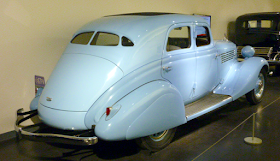For some reason hard to fathom 90 years and more later, American automobiles did not have storage areas worthy of the name.
For example, even this late-1920s Checker taxi in New York City has no roof rack or other obvious place to store luggage and other large objects. I suppose these were placed between the passengers' knees and the driver's seat.
Trunks became an industry-wide feature during the 1930s, the decade when car design evolution was at tis strongest. The focus here is on four-door sedans because coupés and some two-door sedans, due to their shorter passenger compartments, got integrated trunks sooner than their four-door siblings.
Examples of trunks from that era are shown below. Unless noted, images are of cars listed for sale on the internet.
1929 Auburn 8-90
This Auburn is typical of its time, having no trunk.
1929 Hudson Club Sedan by Biddle & Smart - RM Sotheby's photo
However, some larger upscale cars did have trunks. This Hudson's trunk is conventional, being a separate item placed aft of the main body of the car.
1930 Stutz Monte Carlo, Weymann body - RM Sotheby's
This Stutz appears to have two trunks, a separate unit at the extreme rear as well as a trunk abaft of the passenger compartment accessible from outside. This was extremely rare in 1930 for four-door sedans.
1931 Marmon Sixteen Close-Coupled Sedan by LeBaron - Hyman Auctions photo
Marmon V-16 cars were among the those at the top of the price/prestige ladder, and this one has a trunk attached to the car's body. It is a separate element, not integrated like the Stutz's trunk in the previous image.
1933 Cadillac Town Sedan
By 1933 trunks like this were becoming common on larger cars.
1934 Studebaker Land Cruiser - my photo
Here is an example of an integral trunk several years ahead of its time. The design of this car was derived from the 1933 Pierce-Arrow Silver Arrow.
1935 Buick 41 Club Sedan
More typical is the trunk on this Buick. It remains visually distinct, yet its edges are smoothed into the main body -- a step towards complete integration.
1936 Cord 810 Beverly - Hyman
Standard Cord 810 Westchester sedans had a fastback design incorporating a lidded trunk. Beverly models had fancier interiors and some were given the tacked-on trunk lid seen here to provide some extra storage space.
1936 Lincoln Zephyr - factory photo
Aerodynamically-influenced Zephyrs has integral trunks.
1938 Studebaker Commander
Less radical is the trunk on this Studebaker. In some respects it's similar to that on the 1935 Buick above, but its blending into the body is more complete.
1938 Graham
Now we see an early version of the "bustle back" style common after the war.
1939 Mercury Eight
A "fastback" design like the Zephyr, but this Mercury's trunk is wider and more practical.
1941 Pontiac Torpedo Sedan
By the early 1940s integral trunks were the industry standard.














And that, children, is why we call trunks trunks. Except if you are British, and there is no explanation possible for why they call trunks boots. Everyone knows that boots are tall shoes.
ReplyDelete"Boots" were exceptionally common in the horse and buggy days - from the saddle attachment where a cowhand stored his longarm (a rifle boot) to side compartments where coach passengers stored their baggage (a luggage boot). The name moved along with it when the storage compartment moved to the rear of the vehicle.
ReplyDeleteEarly automobiles were expensive and quickly became fashionable as taxis among travelers. Those who could afford to travel for pleasure frequently used large portable wardrobes for their clothing - there was no accommodation for such large luggage, so taxi operators added a fold-down rack (similar to the boke rack on many buses) in the rear to carry these 'trunks'.
As vehicle ownership became more commonplace (and most vehicles lacked cargo capacity), people saw these and they became semi-permanent features on many cars of the era - some higher-end coach-builders (people who would buy a bare chassis and build the body atop it) began to include the trunk rack as a standard feature (with the option to buy a coordinating trunk, similar to bed covers for modern pickup trucks).
As trunks became more ubiquitous, they were integrated into cars to take advantage of the normally-unused/unusable space behind the rear passenger seat. Being part of the body design had the added feature of offering better environmental protection than an external trunk.
As a note to the author:
The 1930 Stutz Monte Carlo pictured above does not have two trunks - it has an external trunk and a "rumble seat". (For those unfamiliar a rumble seat is an additional seating area just large enough for two adult or three child passengers, typically only used when transporting more passengers than expected.) Rumble seats were primarily used for coupes and roadsters, but were occasionally found on high-end sedans.
As trunks became integrated into the main body, rumble seats became an either/or feature - they could have a trunk or a rumble seat, but no longer both. Buyers overwhelmingly opted for secure cargo capacity they could utilize on a daily basis over extra passenger capacity which would see infrequent use at best, rendering the rumble seat a nostalgic throwback of a bygone era.